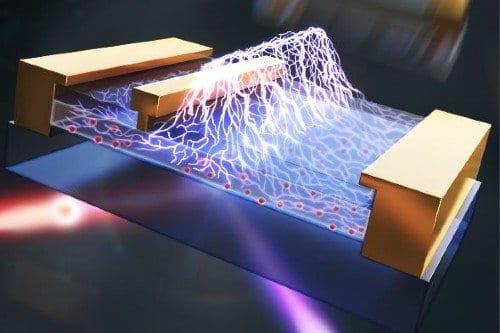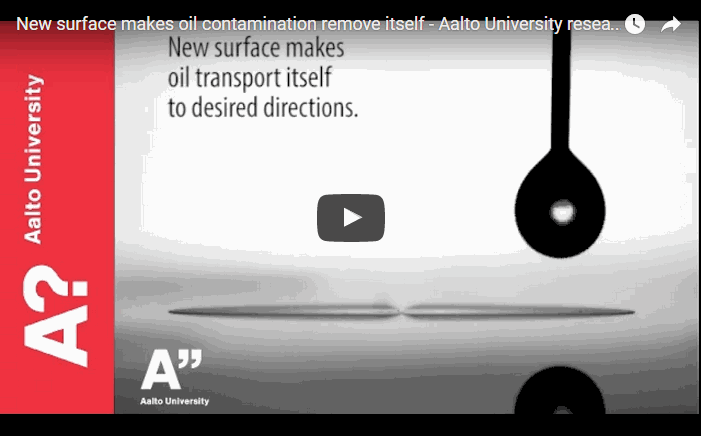
Electrons have distinct energy levels where the energy is minimized, similar to a ball rolling down a mountain to a valley. In the artistically enhanced depiction, a valley in the electronic structure interacts with and is controllably manipulated by circularly polarized laser light. The laser causes valleys with initially equal energies to have slightly different energies. This is the first time a laser has separated energy valleys in an atomically thin semiconductor (tungsten disulfide), which could lead to advanced electronics based on energy valley states instead of conventional electronics based on charge flows and accumulation.
Dressing electrons with a rotating field of laser light creates distinct, controllable states, opening the door for innovative electronics.
The Science
A new semiconducting material that is only three atomic-layers thick has emerged with more exotic, malleable electronic properties than those of traditional semiconductors. These properties come from electrons, like a ball rolling down a hill to a valley, that prefer the lower energy levels at the bottom of electronic energy “valleys.” Now, the valley depth can be shifted optically and with extreme speed with sculpted laser pulses.
The Impact
Layered materials where electrons are constrained to two dimensions can be engineered into novel electronic structures with unique electronic and optical properties. Optical manipulation of electrons can lead to new modes of energy conversion and computational devices such as electronics based on energy valleys states instead of conventional electronics based on charge flows and accumulation.
Summary
A new ultra-thin semiconducting material (tungsten disulfide or WS2) consists of three atomic layers in an “atomic sandwich” configuration with a heavy metal tungsten atom layer between lighter element sulfur atom layers. The material is quasi-two dimensional, just three atoms thick, and exhibits a unique electronic structure with subtle differences depending on the direction relative to the repeating atomic bonds in the layer plane. The differences create two distinct but similar valleys in the electronic structure, where electrons can accumulate with different directions, but with associated energy levels and gaps that are equal.
Adding a specific type of laser beam, where the polarization direction (the direction of interacting electric forces) rotates as the light propagates, creates a new type of electron energy structure that can be probed and manipulated. The electron structural landscape, which began with two similar valleys, can also be made to have different distinct valleys with different energy depths. The valley depth can now be manipulated with light to encode information like zeroes and ones for conventional data. Additionally, changing the energy of the valleys with light allows for fast manipulation without the need for contact with complex electrodes as in conventional electronics.
Learn more: Laser Manipulates Electronic Properties
The Latest on: Innovative electronics
[google_news title=”” keyword=”Innovative electronics” num_posts=”10″ blurb_length=”0″ show_thumb=”left”]
via Google News
The Latest on: Innovative electronics
- Senseonics Partners with Rimidi to Develop Innovative Diabetes Solutionon May 9, 2024 at 1:05 pm
Senseonics Holdings, Inc. (NYSE American: SENS), a medical technology company focused on the development and manufacturing of long-term, implantable continuous glucose monitoring (CGM) systems for ...
- St. Luke’s earns accreditation for electronic records useon May 9, 2024 at 6:26 am
St. Luke’s University Health Network recently received the highest designation a health system can earn for its electronic medical records.
- Charlotte Symphony Launches Innovative MERGE Series at Blackbox Theateron May 9, 2024 at 3:07 am
Charlotte Symphony Orchestra will partner with Blackbox Theater to host experimental immersive events called MERGE: Symphonic x Electronic.
- Innovative electrospinning method creates advanced ceramic nanofibers and springson May 8, 2024 at 5:00 pm
(Nanowerk Spotlight) Ceramics boast impressive strength and durability, but their inherent rigidity and brittleness have long hindered applications demanding flexibility, such as filters, sensors, ...
- Innovative library at Hoover High in Fresno brings students together. Take a look insideon May 7, 2024 at 6:14 pm
The school touts the remodel as an innovative use of space that brings student and ... offers charging stations for electronic devices, and a room for students to meet with academic counselors and ...
- MobileMasr Revolutionizes Egypt’s Second Hand Electronics Landscapeon May 4, 2024 at 10:24 pm
In a country with over 100 million cellphone users and limited consumer purchasing power, Egypt’s second hand mobile market has become an ...
- Ramsey Electronics Launches New Website to Enhance Customer Experience and Expand Reachon May 1, 2024 at 10:26 pm
The revamped site offers a fresh, modern design and a host of new features to improve user experience and showcase Ramsey Electronics' innovative products. The new website was designed to attract new ...
- GLOBALink | Decoding Canton Fair: Latest trend of innovative electronicson April 29, 2024 at 12:31 am
The 135th session of the China Import and Export Fair is in full swing in Guangzhou, South China's Guangdong. The event features many fascinating products from cutting-edge innovations to exquisite ...
- Costco’s Innovative Offer: Exchange Old Electronics for Free Groceries – Here’s How to Benefiton April 18, 2024 at 11:31 pm
Costco’s Trade-In program is a hidden gem for savvy shoppers, offering a convenient way to turn outdated electronics into valuable store credit. For regular Costco customers who appreciate the ...
- New colorful plastic films for versatile sensors and electronic displayson April 14, 2024 at 5:00 pm
Innovative electronics is one of the many applications of modern plastics. Some recent research efforts have used plastic to improve the color realism of display technologies. Now, in a study ...
via Bing News










